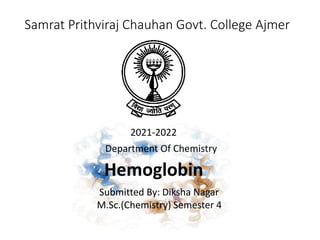
Haemoglobin
- 1. Samrat Prithviraj Chauhan Govt. College Ajmer 2021-2022 Department Of Chemistry Hemoglobin Submitted By: Diksha Nagar M.Sc.(Chemistry) Semester 4
- 2. Content Introduction Structural Feature of Hemoglobin Cooperative Effect Bohr’s Effect Oxygen Dissociation Curve Functions of Hemoglobin Hemoglobin Disorders Reference
- 3. Introduction • The human body contains about 4g of iron. About 70% of this is found as hemoglobin , the red pigment in the erythrocytes (red blood cells). • Each hemoglobin molecules consists of four iron containing parts(heme) and four protein chains(globins). • The fact that blood contained iron was discovered in 1747 by Menghini who showed that if blood was burnt to an ash,iron like particle could be extractred by a magnet
- 4. Structural feature of hemoglobin • Hemoglobin has a molecular weight of nearly 65000, and is made up of four subunits. Each subunit comprises a porphyrin complex heme which contains Fe2+ bonded to four N atoms, and a globular protein called globin. • Each hemoglobin molecule is made up of four globin proteins subunits, two α and two β.The globular protein is coordinated to the Fe2+ in heme through a fifth N atom from a histidine molecule in the protein. • The sixth position around the Fe2+ is occupied either by a dioxygen molecule or a water molecule.
- 5. 141 Amino acid 146 Amino acid Mb 153 Amino acid
- 6. Fe(II) Porphyrins as dioxygen carriers Fe(II) porphyrins without the protein chain (also called naked heme) cannot act as oxygen carriers. They react irreversibly with the dioxygen in aqueous environment forming the µ-peroxo dimer having Fe(III).This peroxo dimer reacts with another heme to give the oxo- bridged dimer called hematin. Hematin is unable to transport dioxygen.
- 7. Role of the Polypeptide chain in Hemoglobin The globin besides acting as a carrier of heme in hemoglobin also plays a role in stabilizing the heme-O2 complex so that oxidation of Fe(II) of heme does not take place and it can act as an effective dioxygen carrier. The polypeptide chains α and β are folded in such a manner that hydrophobic residues are inside and most polar residues are on the exterior. The polypeptide chain prevents the irreversible dioxygen oxidation of Fe(II) in two ways. • The hydrocarbon environment around the iron has a low dielectric constant and is hydrophobic and therefore act as a non-polar and provides non-aqueous environment. • It provides steric hindrance and does not allow the formation of hematin.
- 9. Cooperative Effect Hemoglobin is made up of four subunits, and when one subunit picks up an O2 molecule, the Fe2+ contracts and moves into the the plane of ring. In doing so, it moves the histidine molecule attached to it, and causes conformational changes in the globin chain. Since this chain is hydrogen bonded to the other three units, it changes their conformations too,and enhances their ability to attract O2. This phenomenon is called the cooperative effect. The Four irons can each carry one O2, with generally increasing equilibrium constants.
- 10. Bohr’s Effect CO2 is the end product from the breakdown of glucose to release energy. There is an appreciable build up of CO2 in the muscles. This is removed from the tissue and converted into soluble HCO3 - ions. As the concentration of CO2 increases, formation of biocarbonate causes the pH to decrease and the increased acidity favours release of O2 from the oxyhemoglobin, called the Bohr effect.
- 11. Oxygen Dissociation Curve for Hemoglobin • Oxygen Dissociation Curve (or oxygen saturation curve) is a plot of percentage saturation with dioxygen versus the partial pressure of dioxygen. For hemoglobin the dissociation curve is sigmoidal in shape. As seen in the figure at low partial pressures of dioxygen, hemoglobin does not bind dioxygen effectively. At high partial pressures of dioxygen, hemoglobin has high percentage saturation with dioxygen. The oxyhemoglobin dissociation curve helps in understanding of how blood carries dioxygen from the lungs to the tissues.
- 12. Functions of hemoglobin The Function of hemoglobin is to pick up dioxygen at the lungs. The arteries carry blood to parts of the body where oxygen is required such as the muscles. Here the oxygen is transferred to a myoglobin molecule, and stored until the oxygen is required to release energy from glucose sugar. When O2 is removed from hemoglobin it is replaced by a water molecule. Next the protein part of hemoglobin absorbs H+. Indirectly this helps remove CO2 from the tissues, since CO2 is converted to HCO3 - and H+. The blood removes the more soluble HCO3 - ions and the reduced hemoglobin removes H+. The blood returns to the heart through the veins. It is then pumped to lungs, where the HCO3 - ions are converted back to CO2. This is excreted into the air in the lungs and exhaled. The blood picks up dioxygen again, and the process is repeated.
- 13. Hemoglobin Disorders Sickle cell anaemia Thalassemia CO poisoning
- 14. Reference Bioinorganic and Supramolecular Chemistry By P.S.Kalsi , J.P.Kalsi https://web.iitd.ac.in/~elias/Courses.html E- PG Pathshala
- 15. Thankyou